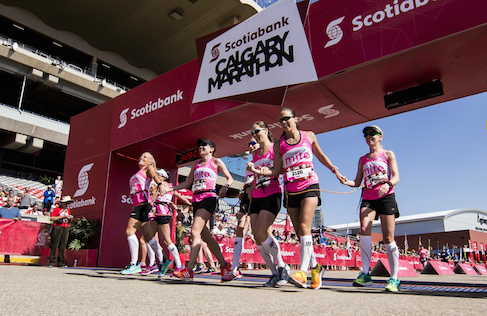
Having a goal race keeps you motivated to move and train more, especially in these cold winter months. That said, with races big and small cropping up across the nation, it seems like race entry fees are on the rise. We spoke with Kirsten Fleming, race director of the Scotiabank Calgary Marathon, to get the breakdown on the real cost of running a race these days—and what you get for what you pay in Calgary.
iRun: How do you set your entry prices?
Fleming: Every race and event for us is different. Part of our mandate at Run Calgary is to be accessible. We put on a months-free event in partnership with a national beer hall called Ale Trail. It’s open to 150 people and it’s a 6K run and a free beer and it costs our team nothing to bring to the community, so it’s free. The flip side is our premier road race, the Scotiabank Calgary Marathon Race Weekend, which is a certified sanctioned Boston Marathon Qualifier that has significant costs associated with it, and those costs are increasing. It’s an event priced for the market and for us as an organization to invest back into the race. No one is getting rich, the event world is tough and participant expectations are high. Let me tell you, as a not-for-profit we are very lean.
iRun: So is it us or has the price of racing really gone up in the past few years?
Fleming: We have graduated pricing and if you get in early, some of our events are less expensive than five years ago. But if you register late, then you pay more, so prices have gone up and down. Race directors have had to get creative in setting prices because our costs are mostly fixed whether we have 1,000 runner sor 10,000—it costs the same to close the roads.
iRun: Tell us about your expenses. What’s the biggest ticket item a race director has to buy?
Fleming: The top-line items are paid to stakeholders like the municipalities we work in for road closures and police officers and to the venue where we operate. For us, to rent Stampede Park and use its services on race day and package pick up. Then, there are direct runner costs that vary such as medals and t-shirts, but the ordering cycle is so early that we are playing a constant guessing game.
iRun: Is there a way the bib prices could come down?
Fleming: It would be tough to bring the costs down without affecting the runner experience. We would have to cut something to really reduce entry fees and as a non-profit, we aren’t running a surplus at year-end.
iRun: Do you have any interesting cost anecdotes? For instance, whats it cost to close down a street and hire off-duty police officers?
Fleming: There are 3,000 line items for one race each year and it’s things that cost money that many people don’t consider. Every cone, feeding volunteers, the gas for truck rentals to move supply stations on the course, 200 port-a-loo rentals and putting WiFi in for the event.

iRun: Makes sense. OK, let’s shift gears from what you spend to what you give back. The Scotiabank Charity Challenge opened this week, tell us about that.
Fleming: The Scotiabank Charity Challenge is the fundraising arm of the Scotiabank Calgary Marathon and it raises one million dollars annually. We work with more than 90 charities that use the event as a fundraising platform and to celebrate awareness of their cause. It’s interesting, the parallel between runners paying for a bib and runners raising money for a good cause.
iRun: It’s cyclical, and one of the best things about the sport. We do something we love and help people in the process. Lastly then, what are people really buying when they purchase a bib?
Fleming: The experience and a victory lap for their many months of hard work in training.





 Current Issue
Current Issue Previous Issue
Previous Issue Prior Release
Prior Release
